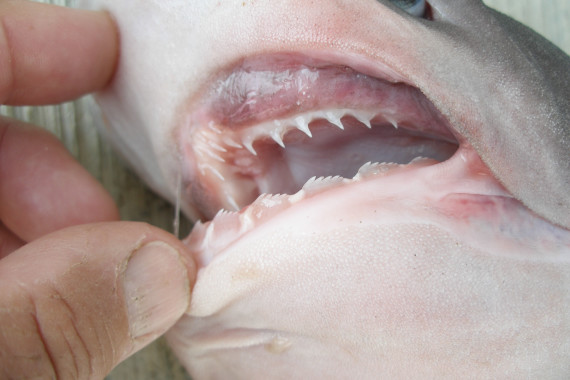Bluntnose Sixgill Shark, Hexanchus griseus

 Bluntnose Sixgill Shark, Hexanchus griseus, Juvenile. Fish provided by the commercial fishermen of the greater Los Cabos area, Baja California Sur, March 2011. Length: 75 cm (30 inches). Identification courtesy of H.J. Walker, Jr., Scripps Institute of Oceanography, La Jolla, California.
Bluntnose Sixgill Shark, Hexanchus griseus, Juvenile. Fish provided by the commercial fishermen of the greater Los Cabos area, Baja California Sur, March 2011. Length: 75 cm (30 inches). Identification courtesy of H.J. Walker, Jr., Scripps Institute of Oceanography, La Jolla, California.
The Bluntnose Sixgill Shark, Hexanchus griseus, is a member of the Cow Shark or Hexanchidae Family, that is also known as the Sixgill Shark and in Mexico as tiburón de seis branquias. Globally, there are three species in the genus Hexanchus, of which two are found in Mexican waters, one in the Atlantic and one in the Pacific Ocean.
The Bluntnose Sixgill Shark has a heavy fusiform body that tapers at both ends. They are either gray, olive-green, or brown dorsally fading to a paler coloration ventrally and have a distinct light-colored stripe along each flank close to their lateral line. Their fins have pale edges. They have a broad head, a broadly rounded snout, large fluorescent green teardrop-shaped eyes, and a wide broadly rounded ventral mouth with six rows of low, blade-like, comb-shaped teeth on each side and 9 smaller single serrated cusped teeth on each side of their upper jaw. They have 6 very long gill slits making them somewhat unique and giving rise to their common name. Their anal fin is smaller than their single dorsal fin which is set far back on the body just behind their pelvic fins; their pectoral fins have broad bases and rounded tips; and, their pelvic fins have straight margins and rounded tips.
The Bluntnose Sixgill Shark is primarily a deep water species living over the outer continental and insular shelves as well as the upper slopes and are found at depths up to 275 m (9,000 feet). They reach a maximum of 4.8 m (15.8 feet) in length and of 590 kg (1,300 lbs) in weight. As of January 1, 2024, the International Game Fish Association world record stood at 589 kg (1,298 lbs) with the fish caught in coastal waters off the United Kingdom in November 2002. They are diurnal being inactive and resting on the bottom during daylight hours and migrating vertically toward the surface and shallow waters to feed at night. They are strong slow swimmers and are normally solitary individuals. They feed on a fairly wide variety of fish and invertebrates. In turn they are preyed upon by sea lions, white sharks, and the Killer Whale or Orca Whales, Orcinus orca. Reproduction is ovoviviparous with eggs hatching inside the females with litter sizes of 22 to 108 individuals that are approximately 70 cm (28 inches) in length. The pups reside on the upper slopes and outer continental shelves before moving to coastal inshore waters. As they mature they move into deeper waters and the adults are seldom found at depths above 81 m (300 feet). They have lifespans of up to eighty years.
The Bluntnose Sixgill Shark is a highly migratory wide-ranging circumglobal species. In Mexican waters they are a resident of the Pacific Ocean but have a limited distribution being found along the entire west coast of Baja and in the southern half of the Sea of Cortez.
The Bluntnose Sixgill Shark cannot be confused with any other species due to its gill count.
From a conservation perspective the Bluntnose Sixgill Shark is currently considered to be NEAR THREATENED. They are often caught as a by-catch of other fisheries by handline, longline, gill nets, traps, and trawls. They are smoked and exported to European markets. They are also used for meat, liver oil, salted and dried food products, fish meal, and pet foods. They have been heavily targeted by sport fisheries and commercial fishermen along the northwest coast of the United States. These fisheries have collapsed due to excessive fishing pressures with a significant decline in the populations for the last twenty years. They are not known to attack humans.